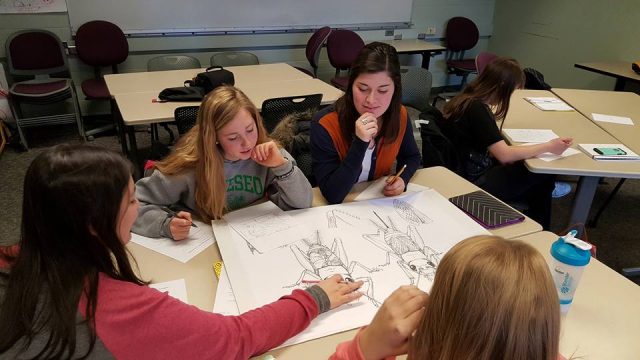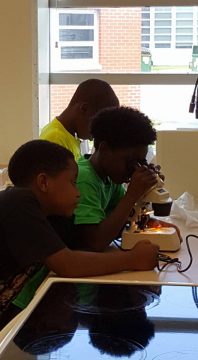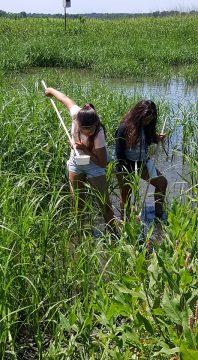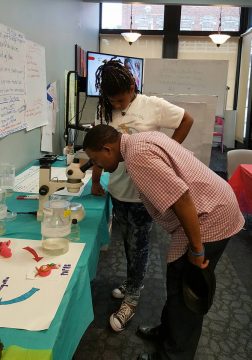Young Scientists and Ambitious Teachers Improving Health in an Urban Ecosystem
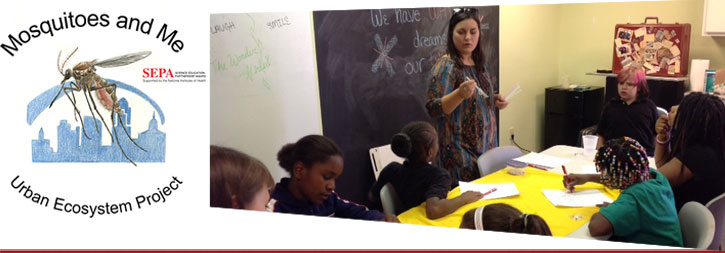
Project Website(s)
SciEd Conference Poster
To view or download the SciEd Conference Poster click the link below.
-
Project Description
Using the theme of mosquitoes and public health, this project brings together pre-service, in-service, and community-based educators to learn about ambitious science teaching principles and practices in support of informal citizen science and enhanced formal science schooling.
-
Abstract
People of color who live in low income, urban communities experience lower levels of educational attainment than whites and continue to be underrepresented in science at all educational and professional levels. It is widely accepted that this under-representation in science is related, not only to processes of historical exclusion and racism, but to how science is commonly taught and that investigating authentic, relevant science questions can improve engagement and learning of underrepresented students. Approaching science in these ways, however, requires new teaching practices, including ways of relating cross-culturally. In addition to inequity in science and broader educational outcomes, people of color from low income, urban communities experience high rates of certain health problems that can be directly or indirectly linked to mosquitoes. Recognizing that undertaking public health research and preventative outreach efforts in these communities is challenging, there is a critical need for an innovative approach that leverages local youth resources for epidemiological inquiry and education. Such an approach would motivate the pursuit of science among historically-excluded youth while, additionally, involving pre-service, in-service, and informal educators in joint participatory inquiry structured around opportunities to learn and practice authentic, ambitious science teaching and learning.
Our long-term goal is to interrupt the reproduction of educational and health disparities in a low-income, urban context and to support historically-excluded youth in their trajectories toward science. This will be accomplished through the overall objective of this project to promote authentic science, ambitious teaching, and an orientation to science pursuits among elementary students participating in a university-school-community partnership promise program, through inquiry focused on mosquitoes and human health. The following specific aims will be pursued in support of the objective: 1. Historically-excluded youth will develop authentic science knowledge, skills, and dispositions, as well as curiosity, interest, and positive identification with science, and motivation for continued science study by participating in a scientific community and engaging in the activities and discourses of the discipline. Teams of students and educators will engage in community-based participatory research aimed at assessing and responding to health and well-being issues that are linked to mosquitoes in urban, low-income communities. In addition, the study of mosquitoes will engage student curiosity and interest, enhance their positive identification with science, and motivate their continued study. 2. Informal and formal science educators will demonstrate competence in authentic and ambitious science teaching and model an affirming orientation toward cultural diversity in science. Pre-service, in-service, and informal educators will participate in courses and summer institutes where they will be exposed to ambitious teaching practices and gain proficiency, through reflective processes such as video study, in adapting traditional science curricula to authentic science goals that meet the needs of historically excluded youth. 3. Residents in the community will display more accurate understandings and transformed practices with respect to mosquitoes in the urban ecosystem in service of enhanced health and well-being. Residents will learn from an array of youth-produced, culturally responsive educational materials that will be part of an ongoing outreach and prevention campaign to raise community awareness of the interplay between humans and mosquitoes. These outcomes are expected to have an important positive impact because they have potential for improving both immediate and long-term educational and health outcomes of youth and other residents in a low-income, urban community. -
Dissemination Strategies
Dissemination of materials stemming from the project will be accomplished in a number of ways. Using ISU’s website hosting capacity, a project website will be developed and linked both to the ISU 4U Promise website and to the College of Human Sciences website. Updates on the work being done at the schools, in the community, and in the teacher education program will be shared via this website, including summaries of data collected by youth inquiry teams and student-produced outreach products. Many materials on this site will be written for consumers who are non-science specialists. Recognizing that new media, other than a website, may be more useful for disseminating the above information, we will be using those other options, as well. Particularly because we are working with youth and positioning them as producers of knowledge, we will embrace their use of social media and explore its use as a dissemination tool.
-
Project Evaluation(s)
Censeo Solutions, Inc. will serve as the evaluator for the project. The Censeo team will utilize the existing project logic model in order to identify process and outcome measures; develop, identify and administer data collection tools; analyze data; and, report results. Given the defined aims of the project, a goal-based evaluation approach will be utilized. This will allow for assessment of process and outcome measures in relation to impact on program participants.
The evaluation of the initiative will analyze project inputs, outputs and outcomes in order to: quantify the scope and activities of the project, asses the quality of project components, and understand the impact of the project on the target populations. It is imperative that outcomes, and corresponding performance measures, be identified which asses the process of project implementation, as well as the end result of the program. In this sense, assessment of what results from the project does not overshadow assessment of how the project is implemented. Both process and outcome measures will be aligned with short, medium and long terms goals of the project identified within the logic model.
Program evaluation activities will extend across the three populations of interest in the project: students, teachers, and community members. -
Resources for Sharing
An important objective of this project is the refinement and articulation of a framework that combines elements of successful teacher education for historically-excluded populations with authentic science inquiry. It is important that this framework or model be made available to a range of stakeholders, and this will be done through publications and presentations. A resource that will be made available is video examples of culturally-responsive, ambitious science teaching to benefit others interested in the preparation of science educators. The teacher education program at ISU will be intricately involved in this project. Thus, there are opportunities for pre-service teacher learning, and professional development with in-service teachers and community educators. We are currently recruiting graduate students student who will benefit from the research training and other learning that will come from participation in the project.
Project Photos
Project Audience
Elementary students, pre-service teachers, in-service teachers, informal educators, community members.
Subjects Addressed
Science teaching, mosquitoes, infectious disease, public health.


